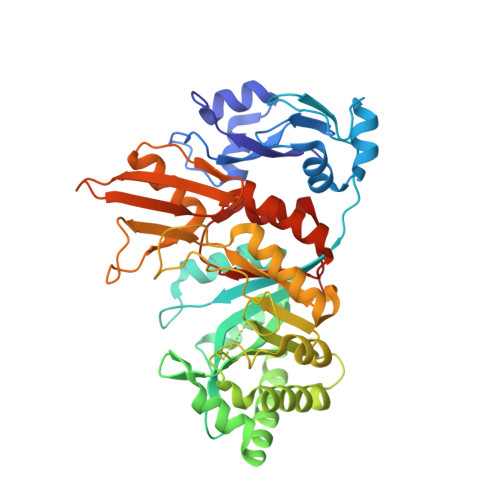Structural and functional analysis of SleL, a peptidoglycan lysin involved in germination of Bacillus spores.
Ustok, F.I., Chirgadze, D.Y., Christie, G.(2015) Proteins 83: 1787-1799
- PubMed: 26190134
- DOI: https://doi.org/10.1002/prot.24861
- Primary Citation of Related Structures:
4S3J, 4S3K - PubMed Abstract:
A major event in the germination of Bacillus spores concerns hydrolysis of the cortical peptidoglycan that surrounds the spore protoplast, the integrity of which is essential for maintenance of dormancy. Cortex degradation is initiated in all species of Bacillus spores by the combined activity of two semi-redundant cortex-lytic enzymes, SleB and CwlJ. A third enzyme, SleL, which has N-acetylglucosaminidase activity, cleaves peptidoglycan fragments generated by SleB and CwlJ. Here we present crystal structures of B. cereus and B. megaterium SleL at 1.6 angstroms and 1.7 angstroms, respectively. The structures were determined with a view to identifying the structural basis of differences in catalytic efficiency between the respective enzymes. The catalytic (α/β)8 -barrel cores of both enzymes are highly conserved from a structural perspective, including the spatial distribution of the catalytic residues. Both enzymes are equipped with two N-terminal peptidoglycan-binding LysM domains, which are also structurally highly conserved. However, the topological arrangement of the respective enzymes second LysM domain is markedly different, and this may account for differences in catalytic rates by impacting upon the position of the active sites with respect to their substrates. A chimeric enzyme comprising the B. megaterium SleL catalytic domain plus B. cereus SleL LysM domains displayed enzymatic activity comparable to the native B. cereus protein, exemplifying the importance of the LysM domains to SleL function. Similarly, the reciprocal construct, comprising the B. cereus SleL catalytic domain with B. megaterium SleL LysM domains, showed reduced activity compared with native B. cereus SleL.
- Department of Chemical Engineering and Biotechnology, Institute of Biotechnology, University of Cambridge, Cambridge, United Kingdom.
Organizational Affiliation:

















